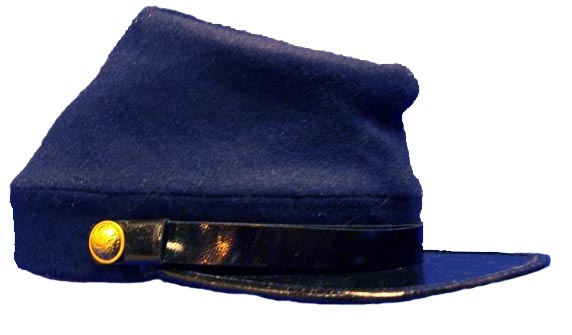Federal
Kepis
|
There are distinct
differences between the US
forage caps of 1858 and the kepi, often referred to as a Chasseur cap.
Although
both caps are an effort to do the same thing, make a lighter and more
serviceable
piece of headgear without the need for stiffening, the dress/work cap
of our US
army before
the civil war was called a shako, a tall, cylindrical cap of cloth over
stiffened felt or pasteboard. It wasn’t until 1872 that the US
issued a
kepi, which looked markedly different from the kepi of the civil war
era.
|

US Indian War Kepi
|

US Kepi
|
At
the time, it was usually a state or volunteer item purchased from
manufacturers of private enterprise. US Commissioned offices were
required to
go to establishments called military furnishers to make their purchase
within
the guidelines of the US War Department. Great latitude was afforded in
the
details of manufacturer but all fit into a defined bracket of
construction. A kepi
consisted of a stiff band of paste board (no reeds or welts); a
lacquered, stiff,
flat, square visor, and a disc top made of fullers board.
|
|
|
|
|
Few had bodies that were
so
generous as to
flop over the visor. The Kepi was a French effort to make a more easy
to
produce version of the shako. Americans in the south preferred the
kepi
over the forage cap and it became a predominate enlisted piece of
headgear.
Union officials displayed their rank via the "Austrian knot," a hat
braid that was of either gold or black, silk, soutache.
|
| |
|
|
|
Visors were almost
always of
leather that could either be unbound or have the more expensive
braiding over
the edge. As a rule, they were nearly always flat and square-shaped.
Visors
were also "glazed" with lacquer to make them waterproof and very
glossy.
|
|
|
In the case of the
private
vs. the officer, even in volunteer regiments, the differences depended
upon expense
in details of manufacture. A cap for a private soldier of a volunteer
regiment would
usually be less expensive than that of an officer. The interior
wouldn't have a
quilted lining, cheaper materials would be used, and the visor would be
unbound. However, having said this it
depended largely upon the economy of the state and the desire of the
individual
to show his ability to purchase, as in the case of an officer.
|
Some volunteer groups
also used soutache or welts to elaborate uniform distinction. Colors
and
details depended upon state or rank military tradition.
|

14th
Brooklyn Officer
|

U.S.
Kepi
|




